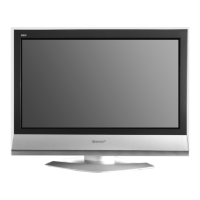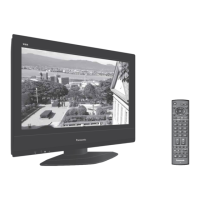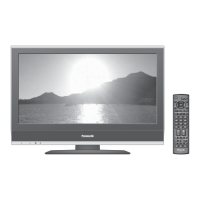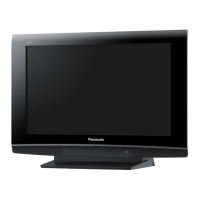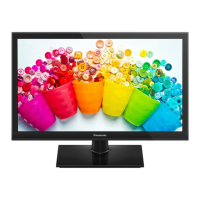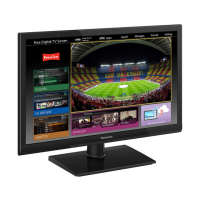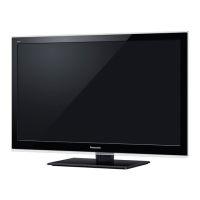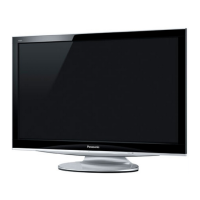Do you have a question about the Panasonic Viera TX-26LXD8 and is the answer not in the manual?
Lists standard and optional items included with the TV for setup and use.
Details the function of buttons on the remote control and the TV's physical controls.
Instructions on safe handling, accessibility, and unplugging the TV when not in use.
Covers avoiding exposure to heat, sunlight, unstable surfaces, and electrical hazards.
Guidelines for gently cleaning the TV screen to avoid damage.
Instructions for cleaning the TV's exterior, stand, and mains plug safely.
Illustrates how to connect a TV aerial for receiving broadcast signals.
Shows how to connect DVD recorders, VCRs, and satellite receivers using various cables.
Guides through plugging in, turning on, and initial TV setup via Auto Setup.
Explains how to set up a personal identification number and details for security.
Instructions on turning the TV on and selecting between DVB and Analogue modes.
Details on selecting programmes using direct number input or the Information banner.
How to set the TV to turn off automatically after a specified period.
Guide to adjusting the picture aspect ratio for optimal viewing.
Explains the nature of DVB teletext and how it differs from analogue teletext.
Instructions on navigating teletext pages using the remote control.
How to access and view the Electronic Programme Guide in different layouts.
Functions for changing layout, viewing different days, and filtering programme lists.
Steps for watching, viewing details, and setting up timer programming via TV Guide.
How to record programmes based on TV Guide information, including split programmes.
Guidance on connecting VCRs, DVD players, and satellite receivers to the TV.
How to choose the correct input source for connected external devices.
Step-by-step guide on accessing and moving through the TV's main menu system.
Instructions on selecting and adjusting picture and sound parameters within the menu.
Steps to navigate the menu to access advanced DVB features.
Information on using Pay-TV modules, the Common Interface, and software system updates.
How to create and manage personal lists of favourite TV programmes (DVB Profile Edit).
Setting up parental controls to lock programmes or inputs using a PIN.
Automatic search and storage of DVB and Analogue programmes.
Detailed steps for manually tuning DVB and Analogue programmes.
Guide to resetting the TV to its original factory condition via "Shipping Condition".
Instructions for entering PIN and personal details for owner identification.
How to label or skip input terminals for easier selection in the input menu.
Setting programmes to record using the TV's timer programming function.
Overview of features and compatibility for Q-Link and VIERA Link.
Diagrams showing how to connect external equipment using SCART and HDMI.
Steps required to set up equipment for VIERA Link functionality.
Explains automatic input switching, power control, and playback for VIERA Link devices.
How to pause and resume live TV viewing, with recording to HDD.
Diagrams showing recommendations for connecting camcorders, game consoles, and audio systems.
Table detailing which equipment can be connected to each TV terminal (AV1, AV2, AV3).
Explanation of how the TV automatically adjusts aspect ratio for optimal viewing.
Information on connecting high-definition devices via HDMI, including cable requirements.
Pin assignments and signal types for SCART, S-Video, and HDMI input terminals.
Lists the video signal formats compatible with COMPONENT and HDMI inputs.
Troubleshooting for issues like noise, no image, distorted picture, and spots on screen.
Solutions for problems such as no sound, low volume, or distorted audio.
Addresses issues related to DVB interference, unusual HDMI pictures, and sound.
Solutions for the TV going into standby, remote control issues, and error messages.
Explains messages related to tuning data, service found, and software updates.
Interprets messages about recording status, media checks, and service availability.
Details on power consumption, standby conditions, and display panel characteristics.
Technical data on audio output, headphone jack, and terminal specifications.
Lists standard and optional items included with the TV for setup and use.
Details the function of buttons on the remote control and the TV's physical controls.
Instructions on safe handling, accessibility, and unplugging the TV when not in use.
Covers avoiding exposure to heat, sunlight, unstable surfaces, and electrical hazards.
Guidelines for gently cleaning the TV screen to avoid damage.
Instructions for cleaning the TV's exterior, stand, and mains plug safely.
Illustrates how to connect a TV aerial for receiving broadcast signals.
Shows how to connect DVD recorders, VCRs, and satellite receivers using various cables.
Guides through plugging in, turning on, and initial TV setup via Auto Setup.
Explains how to set up a personal identification number and details for security.
Instructions on turning the TV on and selecting between DVB and Analogue modes.
Details on selecting programmes using direct number input or the Information banner.
How to set the TV to turn off automatically after a specified period.
Guide to adjusting the picture aspect ratio for optimal viewing.
Explains the nature of DVB teletext and how it differs from analogue teletext.
Instructions on navigating teletext pages using the remote control.
How to access and view the Electronic Programme Guide in different layouts.
Functions for changing layout, viewing different days, and filtering programme lists.
Steps for watching, viewing details, and setting up timer programming via TV Guide.
How to record programmes based on TV Guide information, including split programmes.
Guidance on connecting VCRs, DVD players, and satellite receivers to the TV.
How to choose the correct input source for connected external devices.
Step-by-step guide on accessing and moving through the TV's main menu system.
Instructions on selecting and adjusting picture and sound parameters within the menu.
Steps to navigate the menu to access advanced DVB features.
Information on using Pay-TV modules, the Common Interface, and software system updates.
How to create and manage personal lists of favourite TV programmes (DVB Profile Edit).
Setting up parental controls to lock programmes or inputs using a PIN.
Automatic search and storage of DVB and Analogue programmes.
Detailed steps for manually tuning DVB and Analogue programmes.
Guide to resetting the TV to its original factory condition via "Shipping Condition".
Instructions for entering PIN and personal details for owner identification.
How to label or skip input terminals for easier selection in the input menu.
Setting programmes to record using the TV's timer programming function.
Overview of features and compatibility for Q-Link and VIERA Link.
Diagrams showing how to connect external equipment using SCART and HDMI.
Steps required to set up equipment for VIERA Link functionality.
Explains automatic input switching, power control, and playback for VIERA Link devices.
How to pause and resume live TV viewing, with recording to HDD.
Diagrams showing recommendations for connecting camcorders, game consoles, and audio systems.
Table detailing which equipment can be connected to each TV terminal (AV1, AV2, AV3).
Explanation of how the TV automatically adjusts aspect ratio for optimal viewing.
Information on connecting high-definition devices via HDMI, including cable requirements.
Pin assignments and signal types for SCART, S-Video, and HDMI input terminals.
Lists the video signal formats compatible with COMPONENT and HDMI inputs.
Troubleshooting for issues like noise, no image, distorted picture, and spots on screen.
Solutions for problems such as no sound, low volume, or distorted audio.
Addresses issues related to DVB interference, unusual HDMI pictures, and sound.
Solutions for the TV going into standby, remote control issues, and error messages.
Explains messages related to tuning data, service found, and software updates.
Interprets messages about recording status, media checks, and service availability.
Details on power consumption, standby conditions, and display panel characteristics.
Technical data on audio output, headphone jack, and terminal specifications.
| Screen Size | 26 inches |
|---|---|
| Resolution | 1366 x 768 |
| Display Type | LCD |
| Aspect Ratio | 16:9 |
| Brightness | 500 cd/m² |
| Response Time | 8 ms |
| HDMI Ports | 2 |
| Component Video Inputs | 1 |
| Composite Video Inputs | 1 |
| Viewing Angle | 178° |
| USB Port | No |
| VGA Input | 1 |
| Scart Sockets | 2 |
| Audio Output | 2 x 10W |
| Built-in Tuner | Yes |
